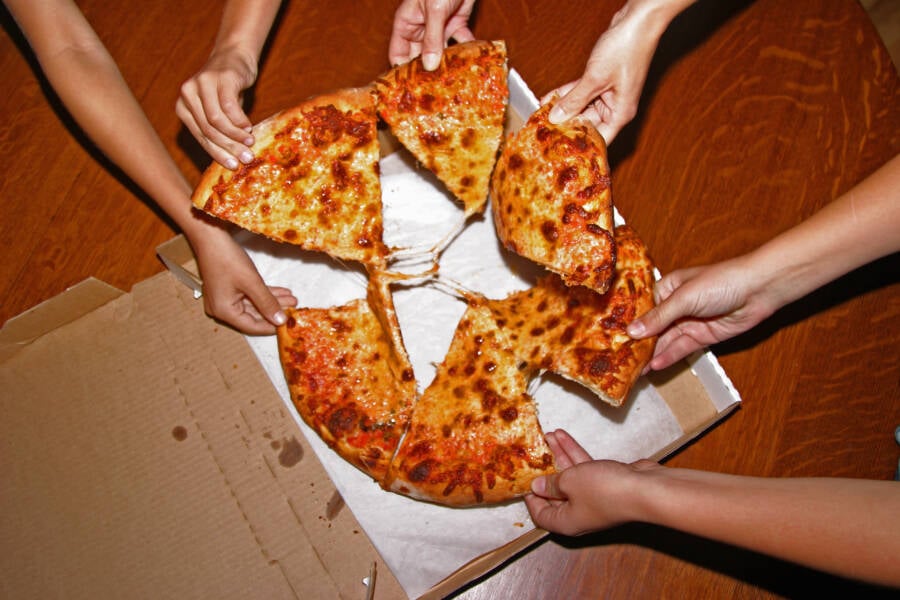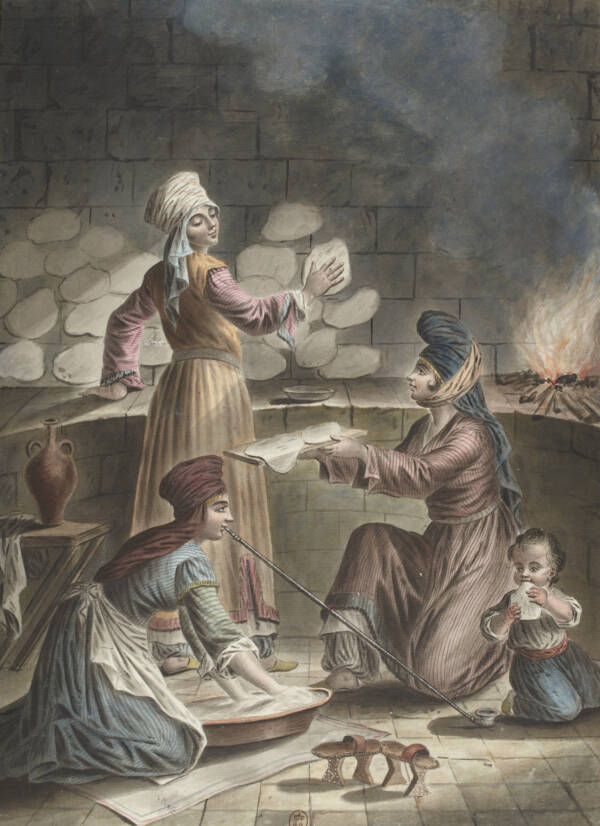Although the invention of pizza as we know it occurred in 18th-century Naples, the full history of this beloved dish stretches back to ancient Egypt, Rome, and Greece.

Eric Savage/Getty ImagesToday, the worldwide pizza market is estimated at around $141 billion.
No matter how you slice it, pizza is one of the world’s most popular foods.
By some accounts, it is the most popular dish around the globe, and whether you prefer Chicago-style deep dish pizza or a nice slice of New York thin-crust, it’s likely that you associate pizza with its home country, Italy. But the true history of where and when this dish originated, and who invented pizza itself, is more complicated.
Though it might be difficult to name the exact person who invented pizza, we can trace pizza’s origins to a general time and place: 18th-century Naples. But while Naples may be the birthplace of the modern pizza pie, the history of pizza goes back a good bit further — and the way it evolved is thoroughly surprising.
Many say that pizza was invented by baker Raffaele Esposito in Naples for the royal visit of Queen Margherita in 1889, but these flatbreads had been eaten throughout Italy for centuries before, with the first documented use of the name appearing in the city of Gaeta in 997 C.E.
This is the true history of who invented pizza and how it became the world’s favorite food.
The Origins Of Pizza In Ancient Flatbreads
For thousands of years, humans have been combining different herbs, spices, vegetables, fungi, and meats to make dishes that not only served the purpose of sustaining life, but tasted good too. It only makes sense, then, that some of these combinations would look a lot like pizza.
Archaeologists working in Sardinia found evidence of leavened bread being baked around 7,000 years ago. As time went on, people decided to add a bit of flavor by incorporating oils, vegetables, meats, and spices.

Fine Art Images/Heritage Images/Getty ImagesTurkish women baking flatbreads.
According to Science Trends, by the sixth century B.C.E., Persian soldiers under the rule of King Darius I were topping flatbreads with dates and cheese. The ancient Chinese made a round flatbread called bing. India had a fat-infused flatbread called paratha. You can find similar flatbreads in other South and Central Asian cultures, including roti and naan.
Perhaps the most similar to modern pizza, however, were the flatbreads of the ancient Mediterranean, particularly Greece and Egypt. Here, flatbreads were topped with a combination of oils, spices, and fruits — likely, some of the same toppings that are put on modern-day Mediterranean-style flatbreads.
Ancient Roman historians later chronicled the dishes in their various accounts. In the third century C.E., Cato the Elder wrote of a round flatbread topped with herbs and olives. In the fifth century C.E., Virgil wrote of a similar dish. Archaeologists later recovered cooking utensils that could have been used to make pizza-like dishes from the ruins of Pompeii, which means they date back to at least the Mt. Vesuvius eruption around 72 C.E.

Werner Forman/Universal Images Group/Getty ImagesA painting in the tomb of Senet showing ancient Egyptian bread making.
Of course, none of these foods were pizza, but they were similar. So who invented pizza?
It isn’t difficult to see how the concept of a “pizza” found its way to Italy. It was here that the modern pizza came to be, but its creation may have been due to necessity more than anything else.
The History Of Pizza In Italy
Naples began its life as a Greek settlement around 600 B.C.E., but by the 18th and 19th centuries C.E., it had become an independent kingdom and a thriving city in its own right. It was also notorious for having a high percentage of poor workers.
“The closer you got to the bay, the more dense their population, and much of their living was done outdoors, sometimes in homes that were little more than a room,” Carol Helstosky told HISTORY. Pizza was invented around this time. Helstosky, an associate professor of history at the University of Denver who authored the book Pizza: A Global History, explained that working poor Neapolitans needed a cheap meal that could be quickly eaten.
Pizza served this purpose well, and the poor Neapolitans enjoyed their bread topped with tomatoes, cheese, anchovies, oil and garlic while those of a higher social class looked on, aghast at the poor’s “disgusting” eating habits.
Meanwhile, the rest of the Western world began to colonize previously uncharted lands, and Napoleon set his sights on Naples, conquering the city in 1805 and holding it until he was forced to abdicate his throne in 1814. It wasn’t until 1861 that Italy unified and Naples officially became an Italian city.
Why Raffaele Esposito Became Known As The Man Who Invented Pizza

Apic/Getty ImagesQueen Margherita of Savoy, the woman for whom the Margherita Pizza is named.
In 1889, Italian King Umberto I and Queen Margherita of Savoy visited Naples and the queen expressed a desire to enjoy the best food Naples had to offer. Their royal chef recommended the food of Raffaele Esposito, the owner of Pizzeria Brandi (formerly Di Pietro pizzeria).
Esposito presented the queen with three pizzas: pizza marinara (with garlic), a pizza with anchovies, and a three-ingredient pizza topped with tomatoes, mozzarella cheese, and basil. The queen loved the third pizza so much, Esposito named it after her: Pizza Margherita.
Esposito’s fame reached soaring heights following the royal visit, but the now world-famous dish didn’t become an instant hit in Italy. In fact, pizza took off in America well before the rest of Italy went through its own pizza craze.
Regardless Of Where And When Pizza Was Invented, It’s Become A Worldwide Sensation
In 1905, Gennaro Lombardi opened G. Lombardi’s on Spring Street in Manhattan, making his pizzeria one of the first documented joints to sell the dish with a license. By most accounts, G. Lombardi’s was the first American pizzeria, but it didn’t take long for similar restaurants to pop up all across New York, Chicago, Boston, New Jersey, and anywhere else Neapolitan immigrants were settling.

Mark Peterson/Corbis via Getty ImagesA group of chefs making pizza at Lombardi’s pizzeria in New York.
The same thing was happening across different parts of Europe. Immigrants from Naples brought their favorite dish with them everywhere they went, but pizza went supernova after World War II. By then, pizza was no longer seen as an “ethnic” food in America, and non-Neapolitans were hopping on the wagon, creating their own versions of the beloved food.
In the 1950s, pizza continued to take over the world. Pizzeria owner Rose Totino came up with the brilliant idea of selling frozen pizzas — the same Totino whose name lines the frozen aisles of grocery stores today.
In 1958, the first Pizza Hut opened in Wichita, Kansas. A year later, the first Little Caesars opened in Garden City, Michigan. The next year, it was Domino’s in Ypsilanti. In 1962, a Greek-Canadian named Sam Panopoulos made a name for himself as the man who invented Hawaiian Pizza.
Fast forward to 2001 and Pizza Hut was delivering a 6-inch salami pizza to the International Space Station. Just over a decade after that, NASA-funded scientists constructed a 3D printer that could cook pizza in a minute and fifteen seconds.
As of 2022, PMQ Pizza Magazine reported, the worldwide pizza market was a $141.1 billion industry. In the United States alone, there are over 75,000 pizza store locations, more than half of which are independent.
It’s probably not surprising that pizza is that popular, but the fact is that this really isn’t a new phenomenon. While it’s not clear exactly who invented pizza, for thousands of years, humans have been eating foods similar to pizza — and can we blame ourselves for that?
After this look at the origins of pizza, learn about the surprisingly long history of ice cream and who invented it. Or read about the oddly complicated history of who invented the toilet.





